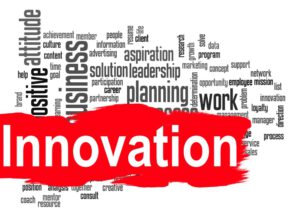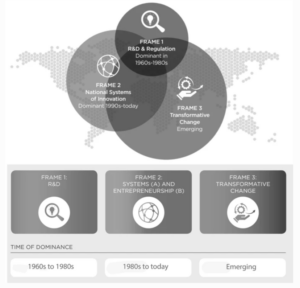Where Social Innovation, Social Entrepreneurship and Climate Change Adaptation Meet – A New Blog Series (Part 1)
Innovation – the New Mantra of Climate Action and Related Funding Instruments? The Long-Awaited Boost to Implement Climate Adaptation and Resilience Faster and More Effectively?
Is ‘innovation’ just a new buzzword in the development and climate change scene, following on from ‘resilience’, ‘sustainability’ and other somehow ambiguous and amorphous terms that mean many things to many people? Or is the current focus on innovation guiding humankind’s Race to Resilience and adding more rigour to overcoming the implementation deficit for adaptation? Will it help to attract and mobilise more funding (both, public and private finance) in order to implement gender-sensitive, socially inclusive and just climate adaptation more widely?
 While it seems to unite a diversity of views and opinions, at the same time it ‘diffuses’ important debates as well as meaningful and constructive processes that are trying to resolve dilemmas and diverging views. There is hardly any relevant new initiative, project or strategy that does not call itself innovative these days. But what is really new in view of the approaches advocated?
While it seems to unite a diversity of views and opinions, at the same time it ‘diffuses’ important debates as well as meaningful and constructive processes that are trying to resolve dilemmas and diverging views. There is hardly any relevant new initiative, project or strategy that does not call itself innovative these days. But what is really new in view of the approaches advocated?
Some say, that ‘Climate Change Adaptation Is The Greatest Entrepreneurial Challenge Of Our Time’ (Forbes 2018). So, why not try to learn from entrepreneurs (even better if they try to include social impacts!)? Can the public sector and the private sector not combine their strengths in order to ‘generate’ social innovation? And if so, how best can this process be supported and enhanced?
Getting on the Same Page – What Is Innovation Actually?
As often with ‘super terms’ (such as resilience, sustainability, transformation etc.) there is no globally accepted definition of innovation. Broadly speaking, there are three types of innovation: (1) technologies, (2) processes and practices and (3) policies or a combination of these. Disregarding a sectoral or thematic focus, most innovation demonstrates one of the following characteristics:
- Newness and novelty (at least in the location of its application)
- Improvement and adjustment
- Spread of use, application, or practical implementation (scaling-up)
Innovation has a long conceptual history (see Gregorowski and Bours, 2022). Descended from similar concepts like ‘imitation’ and ‘invention’, the concept of innovation was cultivated during the 20th-century, notably by Austrian economist Joseph Schumpeter.

Innovation was driven by research and development (R&D) which we thought to be vital in the effort to overcome market failures (Frame 1). Highly influenced by entrepreneurs, Frame 2 is still focused on economic growth, but the innovation process is characterised by a focus on technology as the driver of innovation and has been about developing new or improving existing technologies to generate efficiencies and maximise profits. The actors involved in innovation are understood to be more diverse than in Frame 1 having complex, dynamic relationships.
The emergent frame (3) has developed with the growing awareness of societal challenges. Many entrepreneurs have been employing their skills to generate innovative solutions to more social and environmental problems, beyond financial incentives. This mission-oriented (rather than primarily profit-oriented) type of innovation is referred to as social innovation and sees the private sector merge more readily with the public sector to tackle issues including climate change.
What Outcomes Motivate Innovators?
The outcomes of innovation can be roughly divided into two categories. Category A outcomes often result from market-focused (Frame 1 & 2) innovation, with Category B outcomes being somewhat neglected or of a lesser priority for market-focused innovation. With the emergence and traction gained by social (Frame 3) innovation, Category B outcomes are increasingly prioritised.
Category A (for-profit, mostly private benefits for the innovator and the beneficiary) outcomes include:
- improved product quality
- creation of new markets
- reduced labour costs
- improved production processes
- reduced consumption of materials
Category B (not-for-profit, mostly public benefits) outcomes include:
- reduced environmental damage/ pollution
- enhanced social justice
- reduced climate vulnerability
- increased climate resilience
- reduced inequality
In market-based economies, it is difficult to imagine a social innovation that does not interact with the market or produce private benefits (such as profit). As a result, it is important to note that any innovation will likely be leading to a mix of Category A and B outcomes, and ideally be of transformative nature. The shift from Frame 1 & 2 innovation thinking to Frame 3 innovation (social innovation) has led to the prioritisation of Category B outcomes that have public benefits.
So… having said all this, key questions still remain: How does market-based social innovation work? Is adaptation to climate change (a somehow new and wicked problem) almost by default an innovation? Who are these social entrepreneurs and innovators, and what are their needs in terms of support? Are business strategies and social change compatible? And how can we make them work to enhance climate resilience? What are the most effective ways to fund these public-private joint ventures for social impact?
If these questions raise your interest, please come back and read our upcoming posts in this series.

Thanks for the great article! Really interesting for me to see how the “old term” of innovations is brought into the context of climate adaption needs. I find it appealing and stimulating! I would like to add, that there is another evolutionary perspective considering the field of innovation, which addresses the three maturity levels of “closed innovation”, “open innovation” and “collective innovation”. “Closed innovation” means secretly developing in our in-house R&D and then with a Big Bang surprising the customers and markets (being ourselves surprised if they need the innovation or not, haven’t practiced any design thinking or staff like that). Closed innovation is an old economy approach, mainly driven by the financial KPI´s. “Open innovation” is probably mainstream these days, you develop your innovations with 1, 2, 3 partners, joining resources in terms of money and competencies for e.g. developing a new “smart” IT solution. Allows more variety, often driven by research interests on specific topics. 50:50 chance if it just generates some interesting research results, or if it becomes a profitable solutions with scalable effects. The third term – and this is why I am writing this long story – “collective innovation” describes in my eyes perfectly what innovation in the context of climate change adaption needs: Putting the real needs of the people, farmers, animals, plants, public authorities, companies etc. in the center, and then starting to innovate… so it is also not only driven by the “Oh, I feel so concerned, I wanna do something”-thing… “Collective innovation” is where classical business and social innovation meet, together with the research of universities and all new data that comes in e.g. through citizen science.